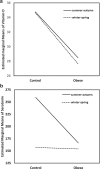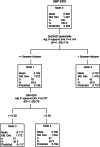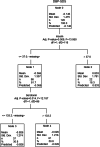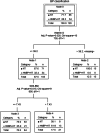Hypertension in obese children is associated with vitamin D deficiency and serotonin dysregulation
- PMID: 35581625
- PMCID: PMC9112480
- DOI: 10.1186/s12887-022-03337-8
Hypertension in obese children is associated with vitamin D deficiency and serotonin dysregulation
Abstract
Background: Obesity and hypertension represent serious health issues affecting the pediatric population with increasing prevalence. Hypovitaminosis D has been suggested to be associated with arterial hypertension. Serotonin by modulating nitric oxide synthase affect blood pressure regulation. The biological mechanism by which vitamin D specifically regulates serotonin synthesis was recently described. The aim of this paper is to determine the associations between vitamin D, serotonin, and blood pressure in obese children.
Methods: One hundred and seventy-one children were enrolled in the prospective cross-sectional study. Two groups of children divided according to body mass index status to obese (BMI ≥95th percentile; n = 120) and non-obese (n = 51) were set. All children underwent office and ambulatory blood pressure monitoring and biochemical analysis of vitamin D and serotonin. Data on fasting glucose, insulin, HOMA, uric acid, and complete lipid profile were obtained in obese children.
Results: Hypertension was found only in the group of obese children. Compared to the control group, obese children had lower vitamin D and serotonin, especially in winter. The vitamin D seasonality and BMI-SDS were shown as the most significant predictors of systolic blood pressure changes, while diastolic blood pressure was predicted mostly by insulin and serotonin. The presence of hypertension and high-normal blood pressure in obese children was most significantly affected by vitamin D deficiency and increased BMI-SDS.
Conclusions: Dysregulation of vitamin D and serotonin can pose a risk of the onset and development of hypertension in obese children; therefore, their optimization together with reducing body weight may improve the long-term cardiovascular health of these children.
Keywords: Children; Hypertension; Obesity; Serotonin; Vitamin D.
© 2022. The Author(s).
Conflict of interest statement
The authors declare that they have no competing interests.
Figures




Similar articles
-
Serum 25-hydroxyvitamin D is associated with insulin resistance independently of obesity in children ages 5-17.Prim Care Diabetes. 2020 Dec;14(6):741-746. doi: 10.1016/j.pcd.2020.06.006. Epub 2020 Jun 29. Prim Care Diabetes. 2020. PMID: 32616391
-
Metabolic disturbances and cardiovascular risk factors in obese children with vitamin D deficiency.Arch Pediatr. 2020 Apr;27(3):140-145. doi: 10.1016/j.arcped.2019.12.005. Epub 2020 Jan 16. Arch Pediatr. 2020. PMID: 31955958
-
[Assessment of relationship of lipid and carbon profile indicators with vitamin D supply in children depending on body mass index].Vopr Pitan. 2021;90(4):112-121. doi: 10.33029/0042-8833-2021-90-4-112-121. Epub 2021 Jul 22. Vopr Pitan. 2021. PMID: 34538041 Russian.
-
Vitamin D intervention as a curative measure for glucose intolerance in obese children and adolescents: a systematic review on randomized control trials.Eur J Pediatr. 2024 Apr;183(4):1475-1483. doi: 10.1007/s00431-023-05407-0. Epub 2024 Jan 11. Eur J Pediatr. 2024. PMID: 38206398
-
Vitamin D status and blood pressure in children and adolescents: a systematic review of observational studies.Syst Rev. 2021 Feb 22;10(1):60. doi: 10.1186/s13643-021-01584-x. Syst Rev. 2021. PMID: 33618764 Free PMC article.
Cited by
-
Can Vıtamın D Reduce the Need for SSRI by Modulatıng Serotonın Synthesıs?: A Revıew of Recent Lıterature.Curr Nutr Rep. 2025 Mar 1;14(1):39. doi: 10.1007/s13668-025-00630-7. Curr Nutr Rep. 2025. PMID: 40025236 Free PMC article. Review.
-
The Role of Nutraceuticals and Probiotics in Addition to Lifestyle Intervention in the Management of Childhood Obesity-Part 2: Comorbidities.Nutrients. 2025 Apr 28;17(9):1487. doi: 10.3390/nu17091487. Nutrients. 2025. PMID: 40362796 Free PMC article. Review.
-
Latest Knowledge on the Role of Vitamin D in Hypertension.Int J Mol Sci. 2023 Feb 28;24(5):4679. doi: 10.3390/ijms24054679. Int J Mol Sci. 2023. PMID: 36902110 Free PMC article. Review.
-
Untargeted Metabolomics Analysis Using UHPLC-Q-TOF/MS Reveals Metabolic Changes Associated with Hypertension in Children.Nutrients. 2023 Feb 6;15(4):836. doi: 10.3390/nu15040836. Nutrients. 2023. PMID: 36839194 Free PMC article.
References
MeSH terms
Substances
LinkOut - more resources
Full Text Sources
Medical

